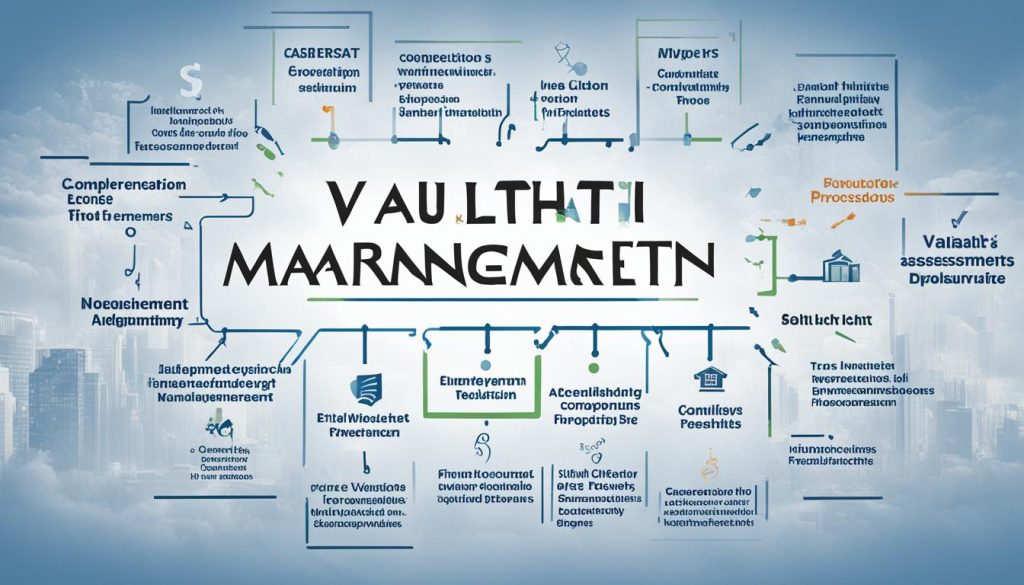Valuing a wealth management firm is a complex process that requires careful evaluation techniques and consideration of key factors. To determine the worth of a wealth management firm, it is important to understand the intricacies involved. Factors such as competence, use of technology, clear communication, credentials, and a balance of technical expertise and emotional intelligence play a significant role in determining the value of a wealth management firm.
Key Takeaways:
- Valuing a wealth management firm is a complex process that requires evaluation techniques and consideration of key factors.
- Competence, technology, communication, credentials, and a balance of technical expertise and emotional intelligence are important factors influencing the valuation.
- The market-based approach, income approach, and asset-based approach are common methods for valuing a wealth management firm.
- The valuation process involves steps such as financial analysis, industry analysis, client analysis, and risk assessment.
- By considering these factors and conducting a comprehensive analysis, the value of a wealth management firm can be determined.
Factors Influencing the Valuation of a Wealth Management Firm
Valuing a wealth management firm involves considering several factors that influence its valuation. These factors play a crucial role in determining the worth of a wealth management firm and are essential considerations in the valuation process.
Competence and Credentials
Competence is a key factor that influences the valuation of a wealth management firm. Technical expertise and a strong understanding of behavioral finance enable wealth advisors to deliver valuable advice and solutions to their clients. A wealth management firm with knowledgeable professionals who possess the necessary credentials and qualifications is generally regarded as more valuable in the marketplace.
Technology as a Tool
The use of technology can significantly impact the valuation of a wealth management firm. Technological advancements have revolutionized the wealth management industry, enabling firms to provide efficient services, streamline operations, and enhance client experience. Firms that embrace technology as a tool, leveraging its capabilities to improve processes and access a wider range of investment opportunities, are often perceived as more valuable.
Clear Communication and Integrity
Clear communication is essential in the wealth management industry as it helps build trust and foster strong client relationships. Firms that prioritize open and transparent communication with their clients and provide regular updates and insights are often highly regarded and valued. Additionally, integrity and professionalism are key factors that influence the valuation of a wealth management firm, as they ensure ethical practices and compliance with industry regulations.
Professionalism and Balance
Professionalism and a balanced approach are crucial factors in determining the value of a wealth management firm. A strong emphasis on professional conduct, adherence to best practices, and the ability to balance technical expertise with emotional intelligence contribute to the overall reputation and value of the firm.
“In the ever-evolving wealth management landscape, firms that demonstrate competence, utilize technology effectively, communicate clearly, and maintain professionalism have a competitive edge in the valuation process.” – Karen Thompson, Wealth Management Expert
By considering these factors and incorporating them into the valuation process, potential investors or acquirers can evaluate the worth of a wealth management firm more accurately.
Methods and Strategies for Valuing a Wealth Management Firm
When it comes to valuing a wealth management firm, there are various methods and strategies that can be employed to determine its worth. Each approach offers unique insights into the firm’s value and can be used in combination for a more comprehensive valuation process.
The Market-Based Approach
The market-based approach involves comparing the wealth management firm to similar businesses in the market. This method relies on the principle of supply and demand, considering factors such as industry trends, competition, and market conditions. By analyzing comparable businesses and their market values, an estimate of the firm’s worth can be derived. This approach is particularly useful when there is an active market for buying and selling wealth management firms.
The Income Approach
The income approach takes into account the firm’s expected future earnings and cash flows. It considers the income generated by the firm and discounts it back to its present value. This approach aims to determine the firm’s value based on its ability to generate income in the future. By evaluating the firm’s profitability, growth prospects, and risk factors, an estimation of its value can be obtained. The income approach is commonly used for valuing service-based businesses, such as wealth management firms, as it focuses on their earning potential.
The Asset-Based Approach
The asset-based approach looks at the tangible and intangible assets possessed by the wealth management firm. Tangible assets include physical assets like office space, furniture, and equipment, while intangible assets encompass goodwill, intellectual property, and client relationships. By assessing the fair market value of these assets and deducting liabilities, an approximation of the firm’s value can be determined. This approach is valuable for firms with significant assets and can provide a more conservative estimate of their worth.
It is important to note that each method has its strengths and weaknesses. The market-based approach may be influenced by market fluctuations, while the income approach relies heavily on accurate financial projections. The asset-based approach may not fully capture the firm’s future earning potential. Therefore, a combination of these approaches is often employed to obtain a more accurate valuation of a wealth management firm.

Steps Involved in Valuing a Wealth Management Firm
Valuing a wealth management firm requires a systematic evaluation process that encompasses various crucial steps. By following these steps, financial analysts can determine the worth of a wealth management firm with accuracy and confidence.
- Financial Analysis: Conduct a comprehensive examination of the firm’s financial statements, including balance sheets, income statements, and cash flow statements. This analysis provides insights into the firm’s financial performance and stability.
- Industry Analysis: Assess the current market conditions and trends within the wealth management industry. Analyzing the competitive landscape and identifying industry-specific opportunities and challenges helps determine the firm’s positioning in the market.
- Client Analysis: Evaluate the firm’s client base, considering factors such as size, loyalty, and demographic profile. Understanding the client mix and the quality of client relationships provides valuable insights into the firm’s potential for future growth and profitability.
- Risk Assessment: Identify and evaluate the risks that may impact the firm’s value. Consider both external risks, such as regulatory changes and market volatility, as well as internal risks, including operational inefficiencies and key personnel dependencies.
- Value Determination: Finally, integrate the findings from the financial analysis, industry analysis, client analysis, and risk assessment to determine the value of the wealth management firm. This valuation takes into account all the relevant factors and provides a comprehensive understanding of the firm’s worth.
By diligently following these steps and conducting a thorough evaluation process, financial experts can accurately assess the value of a wealth management firm. This methodical approach ensures that all necessary factors, including financial analysis, industry analysis, client analysis, risk assessment, and value determination, are considered for an informed valuation.

Conclusion
Valuing a wealth management firm involves careful consideration of numerous factors and the implementation of appropriate valuation methods and strategies. It is essential to recognize the significance of factors such as competence, technology, communication, credentials, and a balance of technical expertise and emotional intelligence in the valuation process. These elements play a crucial role in determining the true worth of a wealth management firm.
The valuation process itself consists of several steps, including in-depth financial analysis, thorough industry analysis, comprehensive client analysis, and rigorous risk assessment. By following these steps and taking into account the key influencing factors, a comprehensive valuation can be obtained for a wealth management firm.
In summary, valuing a wealth management firm requires a thoughtful and meticulous approach. By evaluating the various factors and using appropriate methods and strategies, an accurate valuation can be achieved. The successful valuation of a wealth management firm enables informed decision-making and future planning, ultimately contributing to the growth and success of both the firm and its clients.




No comments! Be the first commenter?